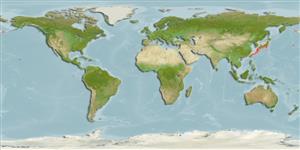>
Acropomatiformes (Oceanic basses) >
Stereolepididae (Giant seabasses)
Etymology: Stereolepis: Greek, stereos = dense + Greek,lepis = scale (Ref. 45335).
Eponymy: Dr Ludwig Heinrich Philipp Döderlein (1855–1936) was a zoologist and palaeontologist. [...] (Ref. 128868), visit book page.
Environment: milieu / climate zone / distribuzione batimetrica / distribution range
Ecologia
marino batidemersale; oceanodromo (Ref. 51243); distribuzione batimetrica 400 - 600 m (Ref. 559). Deep-water
Northwest Pacific: Japan, Russia (Ref. 27683) and South Korea (Ref. 49924).
Size / Peso / Age
Maturità: Lm ? range ? - ? cm
Max length : 200 cm TL maschio/sesso non determinato; (Ref. 559); peso massimo pubblicato: 84.8 kg (Ref. 40637)
Short description
Chiavi di identificazione | Morfologia | Morfometria
Life cycle and mating behavior
Maturità | Riproduzione | Deposizione | Uova | Fecundity | Larve
Masuda, H., K. Amaoka, C. Araga, T. Uyeno and T. Yoshino, 1984. The fishes of the Japanese Archipelago. Vol. 1. Tokai University Press, Tokyo, Japan. 437 p. (text). (Ref. 559)
IUCN Red List Status (Ref. 130435: Version 2025-1)
Threat to humans
Harmless
Human uses
Pesca: commerciale
Strumenti
Special reports
Download XML
Fonti Internet
Estimates based on models
Preferred temperature (Fonte Biblio.
123201): 2.1 - 11.9, mean 7.1 °C (based on 15 cells).
Phylogenetic diversity index (Fonte Biblio.
82804): PD
50 = 1.0000 [Uniqueness, from 0.5 = low to 2.0 = high].
Bayesian length-weight: a=0.01122 (0.00514 - 0.02450), b=3.04 (2.87 - 3.21), in cm total length, based on all LWR estimates for this body shape (Ref.
93245).
Trophic level (Fonte Biblio.
69278): 4.5 ±0.80 se; based on food items.
Resilienza (Fonte Biblio.
120179): Molto basso, tempo minimo di raddoppiamento della popolazione più di 14 anni (Preliminary K or Fecundity.).
Fishing Vulnerability (Ref.
59153): Very high vulnerability (90 of 100).
🛈
